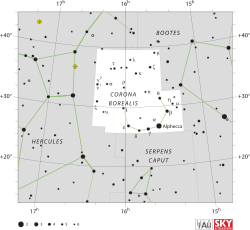- Corona Borealis
-
For the album by the Finnish band Cadacross, see Corona Borealis (album)."Northern Crown" redirects here. For the d20 System game, see Northern Crown (roleplaying game).
Corona Borealis Constellation 
List of stars in Corona BorealisAbbreviation CrB Genitive Coronae Borealis Pronunciation /kɵˈroʊnə bɒriˈælɨs/, genitive /kɵˈroʊniː/ Symbolism The Northern Crown Right ascension 16 h Declination +30° Quadrant NQ3 Area 179 sq. deg. (73rd) Main stars 8 Bayer/Flamsteed
stars24 Stars with planets 3 Stars brighter than 3.00m 4 Stars within 10.00 pc (32.62 ly) 0 Brightest star α CrB (Alphecca or Gemma) (2.21m) Nearest star HD 144579
(46.86 ly, 17.25 pc)Messier objects 0 Meteor showers None Bordering
constellationsHercules
Boötes
Serpens CaputVisible at latitudes between +90° and −50°.
Best visible at 21:00 (9 p.m.) during the month of July.Corona Borealis is a small constellation in the northern sky. Its name is Latin for "northern crown", a name inspired by its shape; its main stars form a semicircular arc. It was one of the 48 constellations listed by the 2nd century astronomer Ptolemy and remains one of the 88 modern constellations.
Contents
Notable features
Stars
Corona Borealis has no first magnitude stars. Its brightest star, α CrB (Alphecca, also known as Gemma) is of magnitude 2.2 (slightly variable) and is considered a member of the diffuse Ursa Major Moving Group. The constellation contains several interesting variable stars: two of the best known are R Coronae Borealis and T Coronae Borealis.
Named Stars
Bayer Name Origin Meaning The Northern Crown α Alphekka/Gemma Arabic "The broken" crown of stars β Nusakan Arabic The two series T Blaze Star English The star that blazes Deep sky objects
Corona Borealis contains no bright deep sky objects. Abell 2065 is a highly concentrated galaxy cluster containing over 400 members, the brightest of which are of 16th magnitude.
Mythology
In Greek mythology, Corona Borealis was sometimes considered to represent a crown that was given by Dionysus to Ariadne, the daughter of Minos of Crete (the story is told by Ovid, Fasti III 459-516). In Welsh mythology, it was called Caer Arianrhod, "the Castle of the Silver Circle", and was the heavenly abode of the Lady Arianrhod (Squire, 2000:154-155). In Arabic mythology, the constellation was known as "the bowl of the poor people" from the Arabic name قصعة المساكين, since the stars form an unsymmetrical pattern with an indent in one side, similar to the bowl of the poor. The Arabs also called the constellation Alphecca (a name later given to [[Alpha Corona Borealis), which means separated or broken up since the stars of Corona Borealis resembles a loose string of jewels.[1]
Equivalents
In Australian Aboriginal astronomy, the constellation is called womera ("the boomerang") due to the shape of the stars.[2]
The Cheyenne nation of Native Americans called the main stars of this constellation the "Camp Circle" as they arranged their camps in a semicircle.
In Chinese astronomy, the stars of Corona Borealis are located within the Heavenly Market enclosure (天市垣, Tiān Shì Yuán)[3]
See also
References
- Ian Ridpath and Wil Tirion (2007). Stars and Planets Guide, Collins, London. ISBN 978-0007251209. Princeton University Press, Princeton. ISBN 978-0691135564.
- Squire, C. (2000). The mythology of the British Islands: an introduction to Celtic myth, legend, poetry and romance. London & Ware: UCL & Wordsworth Editions Ltd.
- ^ Paul Kunitzch and Tom Smart, A Short Guide to Modern Star Names and their Derivations (Harrassowitz, 1986).
- ^ p. 151, Star Lore: Myths, Legends, and Facts, William Tyler Olcott, New York, Dover Publication Inc., 2004
- ^ (Chinese) AEEA (Activities of Exhibition and Education in Astronomy) 天文教育資訊網 2006 年 6 月 26 日
External links
Andromeda · Antlia · Apus · Aquarius · Aquila · Ara · Aries · Auriga · Boötes · Caelum · Camelopardalis · Cancer · Canes Venatici · Canis Major · Canis Minor · Capricornus · Carina · Cassiopeia · Centaurus · Cepheus · Cetus · Chamaeleon · Circinus · Columba · Coma Berenices · Corona Australis · Corona Borealis · Corvus · Crater · Crux · Cygnus · Delphinus · Dorado · Draco · Equuleus · Eridanus · Fornax · Gemini · Grus · Hercules · Horologium · Hydra · Hydrus · Indus · Lacerta · Leo · Leo Minor · Lepus · Libra · Lupus · Lynx · Lyra · Mensa · Microscopium · Monoceros · Musca · Norma · Octans · Ophiuchus · Orion · Pavo · Pegasus · Perseus · Phoenix · Pictor · Pisces · Piscis Austrinus · Puppis · Pyxis · Reticulum · Sagitta · Sagittarius · Scorpius · Sculptor · Scutum · Serpens · Sextans · Taurus · Telescopium · Triangulum · Triangulum Australe · Tucana · Ursa Major · Ursa Minor · Vela · Virgo · Volans · Vulpeculaα (Alphecca / Gemma) • β (Nusakan) • γ • δ • ε • ζ • η • θ • ι • κ • λ • μ • ν¹ • ν² • ξ • ο • π • ρ • σ • τ • υFlamsteed 1 (ο) • 2 (η) • 3 (β, Nusakan) • 4 (θ) • 5 (α, Alphecca / Gemma) • 6 (μ) • 7 (ζ) • 8 (γ) • 9 (π) • 10 (δ) • 11 (κ) • 12 (λ) • 13 (ε) • 14 (ι) • 15 (ρ) • 16 (τ) • 17 (σ) • 18 (υ) • 19 (ξ) • 20 (ν¹) • 21 (ν²) • 23 HerOther Categories:- Corona Borealis constellation
- Constellations
- Northern constellations
- Constellations listed by Ptolemy
- Western constellations
Wikimedia Foundation. 2010.
